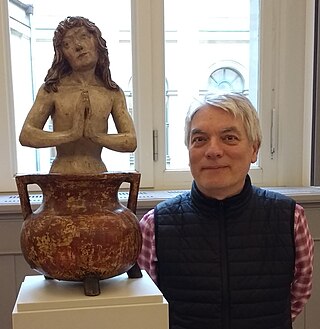
A Hand of Glory is the dried and pickled hand of a hanged man, often specified as being the left hand, or, if the person was hanged for murder, the hand that "did the deed."

Stourbridge is a market town in the Metropolitan Borough of Dudley in the West Midlands, England. Situated on the River Stour, the town lies around 10 miles west of Birmingham. Historically in Worcestershire, it was the centre of British glass making during the Industrial Revolution. The 2011 UK census recorded the town's population as 63,298.

Ulmus glabraHudson, the wych elm or Scots elm, has the widest range of the European elm species, from Ireland eastwards to the Ural Mountains, and from the Arctic Circle south to the mountains of the Peloponnese and Sicily, where the species reaches its southern limit in Europe; it is also found in Iran. A large deciduous tree, it is essentially a montane species, growing at elevations up to 1,500 m (4,900 ft), preferring sites with moist soils and high humidity. The tree can form pure forests in Scandinavia and occurs as far north as latitude 67°N at Beiarn in Norway. It has been successfully introduced as far north as Tromsø and Alta in northern Norway (70°N). It has also been successfully introduced to Narsarsuaq, near the southern tip of Greenland (61°N).
The Bridgewater Four are four men who were tried and found guilty of killing 13-year-old paperboy Carl Bridgewater, who was shot in the head at close range near Stourbridge, England, in 1978. In February 1997, after almost two decades of imprisonment, their convictions were overturned and the three surviving defendants were released; the fourth defendant had died in prison two years into his sentence. Bridgewater's murder remains unsolved.

Wychbury Hill is a hill situated off the A456 Birmingham Road, at Hagley, Stourbridge, on the border of West Midlands and Worcestershire.

The Hagley Obelisk stands close to the summit of Wychbury Hill in Hagley, Worcestershire, approximately 150 metres (490 ft) from the border with the West Midlands. Visible for miles around, and accessible from public footpaths, it was for a while connected with a murder victim discovered on the nearby Lyttelton estate.

Josef Jakobs was a German spy and the last person to be executed at the Tower of London. He was captured shortly after parachuting into the United Kingdom during the Second World War. Convicted of espionage under the Treachery Act 1940, Jakobs was sentenced to death and shot by a military firing squad. He was not hanged since he was captured as an enemy combatant.

Hagley is a village and civil parish in Worcestershire, England. It is on the boundary of the West Midlands and Worcestershire counties between the Metropolitan Borough of Dudley and Kidderminster. Its estimated population was 7,162 in 2019.

The Dyatlov Pass incident is an event in which nine Soviet hikers died in the northern Ural Mountains between February 1 and 2, 1959, under uncertain circumstances. The experienced trekking group from the Ural Polytechnical Institute, led by Igor Dyatlov, had established a camp on the eastern slopes of Kholat Syakhl in the Russian SFSR of the Soviet Union. Overnight, something caused them to cut their way out of their tent and flee the campsite while inadequately dressed for the heavy snowfall and subzero temperatures.

Simon Holt is an English composer.

Keith Hunter Jesperson is a Canadian-American serial killer who murdered at least eight women in the United States during the early 1990s. He was known as the "Happy Face Killer" because he drew smiley faces on his many letters to the media and authorities. Many of his victims were sex workers and transients who had no connection to him. Strangulation was Jesperson's preferred method of murdering, the same method he often used to kill animals as a child.

The Green Bicycle Case was a British murder investigation and subsequent trial pertaining to the fatal shooting of Bella Wright near the village of Little Stretton, Leicestershire, England, on 5 July 1919. Wright was killed by a single bullet wound to the face. The case takes its name from the fact that on the evening of her death, Wright had been seen cycling in the company of a man riding a green bicycle.

The Crawford family murder was the killing of pregnant mother Therese Crawford and her three children at their home in Glenroy, Victoria, Australia, in July 1970. The family car was located at the bottom of a cliff at Loch Ard Gorge in Port Campbell on 2 July with the bodies of the four victims still inside. The husband and father of the decedents, Elmer Kyle Crawford, is the prime suspect in the murders and has not been seen since.

Uffmoor Wood is a semi-natural woodland in Worcestershire, in the English Midlands. It is one of over a thousand woods cared for by the Woodland Trust. The wood has an area of 84.84 hectares, and grid reference SO952811. Sitting at the foot of the Clent Hills and about 3 km southwest of Halesowen, Uffmoor Wood is a popular recreational destination for local people. Adjacent to Hagley Woods, with its mystery of 'Who put Bella in the Wych Elm?', and the site of several pre-war murders, Uffmoor has developed a reputation for the supernatural.

John Walter Guerrier Lund CBE FRS was an English phycologist.
Punt PI is a fact-based comedy radio series on BBC Radio 4 in which Steve Punt investigates mysteries in Britain.

The Mineral, Washington murders, dubbed by the media as "the Tube Sock Killings," is a series of unsolved murders that occurred in remote areas of Lewis and Pierce County, Washington, near the remote community of Mineral, Washington, in 1985. The murder cases were widely publicized, and were featured on the television series Unsolved Mysteries in 1989.

The wych elm cultivar Ulmus glabra 'Nitida' [:'shining', an allusion to the smooth upper surface of the leaves], the smooth glossy-leaved wych, was described by Fries from specimens collected by P. C. Afzelius in 1841 on the island of Stora Karlsö, Sweden, as Ulmus montana nitida, in Novitiae Florae Suecicae: continuatio, sistens Mantissam III: 20 (1842). The Novitiae Florae Gotlandicae (1844) confirmed U. montana f. nitidaFr. as present on the islands of Stora Karlsö and neighbouring Lilla Karlsö off Gotland, Sweden, but did not report it from Gotland proper. A Stora Karlsö specimen from the Herbarium E. Fries is preserved in the Botanical Museum of Uppsala. The tree was listed by Rehder as U. glabraHuds. f. nitida (1915), a designation adopted by Krüssmann (1984), the latter copying Rehder's 'Norway' provenance error.

"Clocaenog Forest Man" refers to an unidentified murder victim found in the Clocaenog Forest in Denbighshire, Wales, in November 2015. The body had lain undiscovered for over 10 years and despite extensive investigations by North Wales Police, national and UK appeals and input from serial killer Peter Moore, the identity of both the body and the murderer(s) remain a mystery.

The Witch Elm is a 2018 novel by Tana French. The novel is a standalone, not related to her Dublin Murder Squad novels.




















